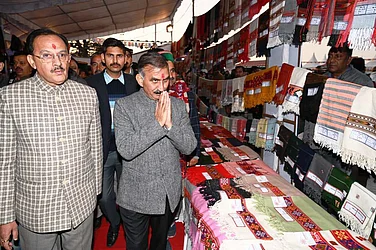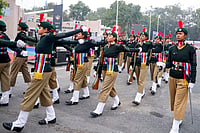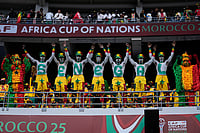In the rich tapestry of human culture, the interplay of language and religion often weaves intricate patterns of identity and division. This essay embarks on a journey through time and ideology, delving into the profound relationship between language, faith, and the socio-political landscape of the Indian subcontinent. We traverse the corridors of history, examining the emergence of Hindi and Urdu as markers of religious identity, a phenomenon that unfolded against the backdrop of colonialism. As we navigate the complex terrain of linguistic nationalism and religious connotations, we unravel the web of influence cast by colonial ideologues and ponder the enduring legacy of their discourse in shaping perceptions of language, faith, and belonging.
In my pursuit of a master’s degree in History at Chaudhary Charan Singh University, a moment of considerable academic significance unfolded within our department, orchestrated by the Head of the Department herself. This event encompassed a 10-day conference dedicated to the thematic exploration of the Kashmir region. During her inaugural address to our esteemed guests, she eloquently expressed, "hum aapka tahe dil se shukrguzar hai" (we are profoundly grateful to you). After the successful conclusion of the conference, certain linguistic purists questioned her, inquiring, "Tumne aakarmankarioyon ki bhasha ka kahan se adhyayan kiya hai?" (From where have you acquired proficiency in the language of the invader?). This encounter deeply unsettled her, as she firmly believed that the language in question did not represent her cultural heritage. In a candid conversation that transpired during my subsequent visit to her office, she shared her experience with these linguistic purists. Ultimately, she resolved to adhere to the language of her cultural heritage, namely Hindi, and forgo alternative linguistic expressions.
A short while later, a similar incident occurred within my locality. While purchasing noodles, I was fortunate to receive prompt service from the cart owner. Overflowing with gratitude, I instinctively uttered "Dhanyavad" (thank you). In response, the owner remarked, “Tumhe Urdu ke alfaz istemal krne chahiyen kyonki Urdu hum musalmano ki zaban hai (You should use Urdu vocabulary because Urdu is the language of Muslims).” This response left me bewildered as I grappled with the question of why certain individuals —both educated and uneducated— held the belief that Hindi and Urdu were exclusive languages for Hindus and Muslims, respectively.
As accurately articulated by Paul R. Brass, a prominent American political scientist, language serves as an “objective characteristic” of a given society. People invariably adopt and employ the language of the society into which they are born, irrespective of their religious beliefs. For example, a non-Muslim born in an Arabic-speaking society will naturally acquire and use Arabic as their primary language, just as a Muslim born in a Hindi-speaking society will do with Hindi.
Languages beyond the faith
The association of Hindi and Urdu with religious identity did not emerge until the latter part of the 19th century. This assertion is substantiated by two notable pieces of evidence. Firstly, in 1837, Urdu replaced Persian as the language in the domains of the court and revenue. During this transition, some native Hindus and Muslims jointly advocated for the retention of Persian, but notably, there were no expressions of support for Hindi.
A second corroborating piece of evidence can be found in the ‘General Report on Public Instruction in the North Western Provinces of the Bengal Presidency for 1846-47’. This report elucidates that students at Benares College exhibited no awareness of the existence of a linguistic form referred to as Hindi. It is worth noting that Benares subsequently emerged as a pivotal center for the Hindi language movement in the latter part of the 19th century.
Colonial construct of language as marker of religious identity
In the lead-up to the latter half of the 19th century, colonial ideologues constructed a substantial body of literature that introduced a discourse asserting the existence of a ‘pure’ Hindu language before the arrival of Muslims in India. According to this narrative, following the settlement of Muslims in India, this previously ‘pure’ language underwent a process of corruption. The alleged corruption entailed the infusion of words from Arabic and Persian into the originally ‘pure’ Hindu language.
Consequently, the resultant linguistic form was deemed as ‘corrupted’, comprising elements from Arabic, Persian, and the original Hindu language. This discourse can be discerned within the works of lexicographers such as Halhed, John Borthwick Gilchrist, W. Yates, Monier Williams, W. Etherington, among others, who contributed to the propagation of this narrative. In effect, this discourse established a narrative framework that primed the indigenous population for conflict.
In addition to fostering this discourse, the colonial government implemented a language policy characterised by ambivalence. Colonial educational policies simultaneously extended support to both Hindi and Urdu. However, a crucial distinction lay in the language proficiency requirements for various administrative positions. Proficiency in Urdu was mandated for administrative roles, whereas individuals proficient in Hindi could secure positions predominantly within the realm of education.
Evolution of Hindi and Urdu into Religious identity markers
Following the replacement of Persian, Urdu assumed the role of the official language within the courts and revenue departments of the British-administered province in North India. Muslims held an advantageous position in securing government employment due to a prevalent tradition among Muslim families to initiate the instruction of Urdu in their children from an early age. The potential acquisition of government positions in administration through the acquisition of Urdu language skills led several Hindus to speculate that the replacement of Urdu with Hindi in the Nagari script would enable them to secure employment opportunities traditionally available to Muslims.
As a result, a movement commenced in the latter part of the 19th century with distinct characteristics. Firstly, the leaders of this movement advocated for Hindi to be designated as the official language of the court and the revenue department. This advocacy bore a striking resemblance to the ‘constructed discourse of the colonial ideologues’ that had been propagated previously. The leaders of this movement consistently echoed the arguments that mirrored those posited by the colonial ideologues. A prominent scholar in the field, Christopher R. King, has demonstrated that proponents of Hindi submitted numerous petitions in favour of its substitution for Urdu in official usage.
Secondly, they embarked on a literary endeavour aimed at purging Hindi of Arabic and Persian vocabulary. Proponents of Hindi portrayed it as indigenous, pure, and legible while characterising Urdu as foreign, impure, and illegible, even resorting to derogatory terms such as “language of prostitutes” in their descriptions.
Finally, their efforts culminated in the Macdonell resolution of 1900. Although the resolution was a symbolic victory for partisans of Hindi, it crystallised the attitude of both communities. Some contemporary newspapers and magazines reflected the sentiments of some “Urdu-speaking elite” Muslims. These individuals went to great lengths to assert that safeguarding Urdu took precedence over even embarking on the Hajj pilgrimage to Mecca.
In conclusion, colonial ideologues formulated a discourse that portrayed Hindi and Urdu as distinctive religious identities, which ultimately contributed to the divisions between Hindus and Muslims. Regrettably, even in contemporary times, certain individuals persist in regarding Hindi and Urdu as possessing religious connotations, despite the economic considerations that initially fuelled this debate. The legacy of these colonial constructs continues to shape perceptions of language and identity in the Indian subcontinent.
(Mohd Kashif is a Ph.D. Scholar at Department of History of Jamia Millia Islamia, New Delhi. Views expressed are personal.)






















